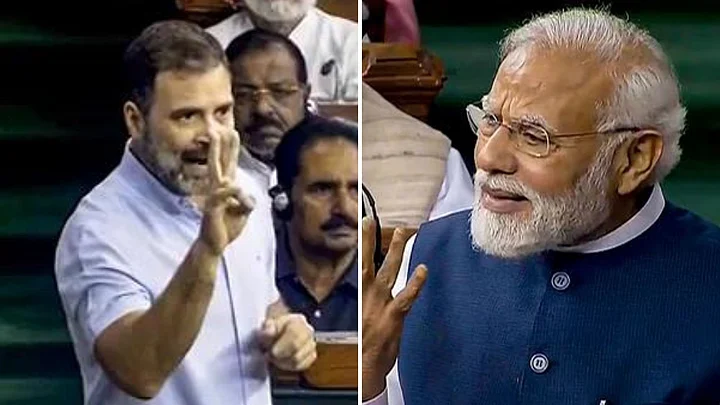The no-confidence debate in Parliament was a showdown between Prime Minister Narendra Modi and Congress leader Rahul Gandhi. While they both spoke on different days, Rahul and Modi took potshots at each other.
Rahul in an emotional outburst accused the BJP of murdering Bharat Mata.
"The BJP government murdered India in Manipur. That is why the prime minister cannot go to Manipur," Gandhi said. He further alleged that PM Modi did not consider Manipur to be part of India.
Modi on the other hand attacked the opposition alliance, saying, “This is not an India alliance, it is an arrogant alliance. Everyone has to become the Prime Minister in this alliance.”
He said the opposition added two "I" to NDA - one is the arrogance of 26 parties, the other is the arrogance of Congress.
As expected the no-confidence motion was defeated. The opposition staged a walkout in the middle of Modi’s speech.
Sentiment Analysis of Parliament Speeches
India Today
A sentiment analysis carried out by India Today live during the speech shows viewers rated Rahul Gandhi’s speech as “Good”.
During Modi’s speech, it changed the method of rating from QR code to emojis, but the rating results were not telecasted live during his speech.
Kanalytics
An AI-based sentiment analysis carried out by Kanalytics, on X (formerly Twitter), shows a potential reach of 2.8 billion for tweets/posts related to Rahul Gandhi’s speech.
It highlights a largely neutral sentiment of 70%, negative sentiment of 26%, and positive sentiment of 4% of Rahul Gandhi’s speech.
Kanalytics shows a potential reach of 3 billion for tweets/posts related to Narendra Modi's speech. It highlights a largely neutral sentiment of 56%, negative sentiment of 37%, and positive sentiment of 6%.
Both positive and negative sentiments for Modi are higher than that of Rahul as he evokes strong emotions as discussed below in detail. An inherent weakness of such AI-based sentiment tools is that they throw up a high neutral sentiment number and Twitter armies of both sides impact such results.
Talkwalker (analysis of tweets in last 24 hours)
Given the backdrop of mutual criticism during their speeches, both Rahul and Modi experienced a considerable drop in net sentiment.
Before his address, Rahul's net sentiment was -1.5, derived from a positive sentiment of 17.9 and a negative sentiment of 19.4. Post-speech, his positive sentiment dramatically dropped to 6.6, while the negative sentiment spiked to 32.3, resulting in a net sentiment of -25.7.
Conversely, Modi began with a net sentiment of -17 before his speech, with a positive sentiment of 13.1 and a negative sentiment of 30.1.
After his address, which included his criticisms of Rahul, his positive sentiment decreased to 8.4, and the negative sentiment surged to 37.3, culminating in a net sentiment of -28.9.
The exchange of criticisms during their speeches evidently had a pronounced effect on the public's perception, as evidenced by the shift in sentiment scores for both leaders.
The results of Kanalytics and Talkwalker are roughly the same with both leaders having a more or less similar net negative sentiment.
A caveat though, the methodology of these AI-based sentiment analysis tools for measuring online sentiment is still evolving and may not necessarily reflect actual sentiment.
C-Voter Survey
A CATI survey by C-Voter (sample size 3767) shows 48% respondents opine Modi benefited from the NCM, versus 20% for Rahul.
The sentiment is also negative for Rahul’s “Bharat Mata murdered” statement. 56% of respondents say it was wrong while only 30% say it was right.
A caveat here as well, the sample size is very small, and the CATI method has its own challenges.
Importance of PM candidate in national polls
As per the Axis My India exit poll, for 37% of the respondents, the prime minister candidate was the most important factor while going out to vote in 2019. 25% voted on the basis of the local candidate, while 22% on the basis of the party symbol.
This reflects the increasingly presidential nature of the general elections poll campaign. If the Congress adopts a localized strategy and does not declare a Prime Ministerial face, it excludes a big portion of voters from its target segment, and that’s a big risk.
Rahul Closes the Gap Between Him and Modi
There has been a rise in Rahul's popularity after the Bharat Jodo Yatra. As per a CSDS Survey on 9 Years of Narendra Modi, 27% of respondents want to see him as Prime Minister, almost double from 2014 and +4% from 2019.
However, Prime Minister Narendra Modi’s popularity is still intact at 43%. Rahul has closed the gap from 21% to 16% which is still very high. What this means is that Rahul can fetch the Congress party and the I.N.D.I.A. alliance 10% vote share (27% popularity rating x 37% voting on pm face).
Rahul More Acceptable than Modi
It’s also true that a quarter of the respondents neither like nor dislike both Narendra Modi and Rahul Gandhi. However, almost a quarter (23%) ‘don’t like’ Modi whereas just 16% ‘don’t like’ Rahul Gandhi.
This shows that Rahul is a more acceptable and less polarizing figure. However, in elections, votes are fetched by polarizing figures who evoke strong emotions.
Rahul, over the years, has also emerged as the strongest opponent to Modi. As many as one in every three believes Rahul Gandhi to be the challenger to Modi in 2024.
Will INDIA Partners Oblige?
It remains to be seen whether partners like Mamata Banerjee, Arvind Kejriwal, and Nitish Kumar, agree to this strategy of naming Rahul as the PM candidate.
It’s also clear that even if Congress / INDIA alliance doesn’t name Rahul as its prime ministerial candidate, BJP is likely to make it a Modi versus Rahul contest, irrespective.
